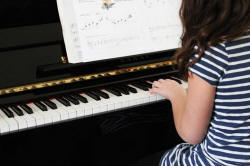TKT Core Module 2: Lesson planning and use of
resources for language teaching
Identifying and selecting aims

The full title of this area is
Identifying and selecting aims appropriate to learners, the stage of learning and lesson types
So, as well as identifying aims, we'll look at how they can be (or can be made) appropriate.
 |
Key concepts in this guideBy the end of this guide, you should be able to understand and use these key concepts:
|
Look out for these words like this
in the text.
There will be tests at the end of the guide for you to check that
you understand the ideas.
In this guide, we will mostly consider aims for a single lesson but all the points apply also to a series of lessons.
 |
Identifying aimsThe first step is to see what an aim actually is. |
  |
Task 1:
Which of the following are aims for lessons? Check here when you have an answer and have written down the numbers for the sentences which are real aims. |
- Students will exchange ideas about sports and pastimes
- The learners will be more confident speakers
- The class will practise making question forms with conditional sentences
- At the end of the lesson, the learners will be more aware of the importance of collocation
- The students will present the findings of their survey to the whole class
- The learners will be able to understand, use appropriately and pronounce the following 10 lexemes ...
- The students will improve their writing skills in terms of planning and selecting appropriate stylistic conventions
- I will present and revise the main uses of the present perfect progressive using a smart board
- The students will mingle to find someone who has selected the same three adjectives to describe their families
- Students will have gained a better understanding of the nature of verbs followed by gerunds and infinitives and be able to use them confidently
Numbers 4, 6, 7 and 10 are real aims
because they tell us what the learners will be able to do by the end of
the lesson. The other ones are descriptions of what will
happen, not what the outcomes will be.
An aim is not the same as a procedure.
 |
Good aims are ...
|
Here's a mnemonic to help you remember the characteristics of good lesson aims. If you can remember the word CLEAR, it will help you. Good aims are:
| Clear | and not only to you. Learners, too, must know what they are trying to achieve. |
| Limited | Too many aims will mean that the lesson loses focus. Both the teacher and the learners will lose a sense of purpose. |
| Explicit | A good lesson plan will also make it clear how the aims will
be achieved. For example, instead of ... The students will have learnt 10 new words to describe emotions it would be more helpful to state ... The students will have understood the negative and positive aspects of the target language by using the items accurately and realistically in a personalised framework. |
| Achievable | Aims need to be realistic in terms of the level of the
learners, the amount of material and the time available. If aims are too ambitious, learners will be discouraged because there will be no sense of progress. If aims are too low, learners will get bored and wonder what use the lesson is. |
| Relevant | Whatever the aims, the skills and knowledge you hope the learners will acquire have to be things they need. |
 |
Why have aims? |
Good question
 |
Task 2:
Think of a couple of good reasons to have clear aims for
lessons. Click here when you have two reasons. |
- They encourage clear thinking about why the lesson is being done at all. When written down, does the aim represent something that my learners need and can achieve?
- They allow us to see if the activities and tasks in the lesson actually contribute to achieving the aims. Aims and procedures should match.
- They allow us to judge success. We can compare the learners' abilities at the end of a lesson to their abilities at the beginning and see if and how far the aims have been met.
 |
Different types of aims |
- aims and objectives
- Some people make a difference between these:
Aims are the things that the teacher wants to achieve in the lesson.
Objectives are the outcomes: what the learners will be able to do at the end.
In this guide, we will use the term 'aim' to cover both but you should know the difference. - main and subsidiary aims
- Few lessons focus only on one target and one topic and a
series of lessons will probably cover lots of different targets
and topics.
Main aims for a lesson will probably describe the one, two or three outcomes that are most important.
Main aims for a series of lessons will be broader and more ambitious.
Subsidiary aims are often either:
a language structure or collection of lexemes that you want the learners to revise or learn during a lesson based on a skill
or
a language skill that you want the learners to practise while focusing on a language structure or vocabulary point. - personal aims
- Teachers also have aims. For example:
I want to reduce the time I spend talking
I will try to use only English for the whole time
I want to change the way I get feedback
and so on.
 |
Matching aims to lesson types |
Lessons come in different sorts and will need different aims:
- presentation lessons
- in which a new skill or structure is met for the first time.
The aim of this sort of lesson will be quite clear and state exactly what structures or lexis or skill or sub-skill the learners will be able to use at the end and at what level of competence. - revision lessons
- in which there is nothing completely new but the learners
need more exposure to the form or the skill.
The aim of a lesson of this type will take into account what the learners already know but state explicitly how it is going to be re-visited and consolidated. - extension lessons
- in which the aim is to broaden, widen or deepen the
learners' abilities in some way.
The aim of this sort of lesson will be clear about where the learners are now and where they will be at the end. - revision plus extension
- in which the learners first revise what they know and then
go on to extend it and apply it.
Here, too, the aim will be clear about where the learners are now and where they will be at the end.
 |
Task 3:
Here are examples but the lesson types and the aims do not
match. Can you arrange the lesson types to match the lesson aims? Click on the table when you have an answer. |

 |
Stage aims |
If, for example, you intend to introduce the lesson by using a
set of kitchen gadgets you have brought from home, why are you doing
this?
You need to be able to state clearly what the aims of this procedure
are. They may be, simply:
To interest the learners in the topic of the lesson
or it may be more specific:
To see how well the learners can use the infinitive structure in, e.g., It's a thing to make pastry flat
Procedures can have a range of aims and aims can be achieved through
a variety of procedures.
What's important, of course, is that they match.
 |
Task
4:
It is useful at the planning stages to think about what each stage
aims to achieve. Try this short test to see if you can match the stage of a lesson to its aims. |
 |
A final point |
Aims are not set in stone.
Good teachers will change the plan as they go along to
respond to
learners' needs so the aim of the lesson may change as the lesson
progresses.
This is not a bad thing because having fixed aims and sticking to
them too mechanically will mean that you can't respond to what the
learners really need.
Teach the learners, not the plan.
 |
Self-test questions |
Before you go on, make sure you can answer these questions. If you can't, go back to the sections which give you trouble.
- What does CLEAR stand for?
- What is the difference between an aim and a procedure?
If you are happy with your progress, go on.
 |
Tests and practice for TKT |
You have done some tests in this guide already but there's one more to do.
| Test 1 | A gap-fill test |
... return to the Module 2 index:
![]()
or go on to the next
guide which is to identifying different
components of a lesson plan.
